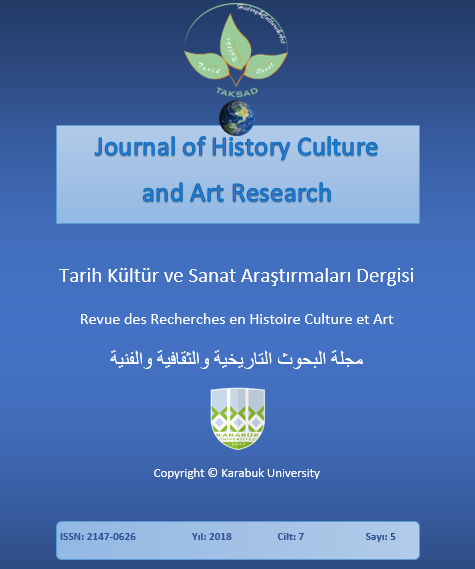Symbolic Study of Color in Bakhtiyari Textiles with Emphasis on Veris (Card Weaving)
DOI:
https://doi.org/10.7596/taksad.v7i5.1757Keywords:
Veris, Color, Bakhtiyari, Card weaving, Nomads.Abstract
Veris is a narrow weaving with a width of 2-10 cm. and a length of 1-8 m., often woven with woolen yarns by simple tools known as cards. This woven has a variety of applications, in the past for decorating clothes, the collar, the edge of the skirt, the belt, baby wrapping, hat bands, saddles and many other uses, the handmade strips were used. But today, more is used to decorate clothes. For the Veris weaving, the Bakhtiyari tribes use many motifs and designs most of which are based on their customs, habits, perceptions, insights, environment and their culture. In this textile, geometric, human, animal, herbal, inscription, positive and negative motifs are used. Red, black, blue, yellow, and dark green are main color in Bakhtiyari hand woven. Each of the colors in the Bakhtiyari tribes symbolizes an event. For example: red Veris for happy event, green Veris is for fastening infant and black tent, yellow Veris for expensive objects, blue Veris for fastening ordinary objects, black and white Veris for mourning events. In short, the composition of colors in the Veris depends on the type of application. This research, by examining the current literature and applying a fieldwork, implements a descriptive & analytical methodology to analyze and understand the “symbolism” in card weaving. The study will examine different motif shapes and explain the meaning of the motif among the Bakhtiyari tribes. For this purpose, different car woven samples will be illustrated and pictured for the reader. The study concludes that card weaving has decorative and functional meanings.
References
Amirahmadian, Babak (2008). A Survey on Bakhtiyari tribe. Tehran: Agah Publication.
Amini, Shahla (2005). Iranian Decorative Bands, Golestan Art, 2, 106-116.
Amini, Shahla (1995). Narrow Band woven in Iran's Tribes and its adaptation to today's life. Master's thesis, Handicrafts, Isfahan Art University.
Daneshgar, Ahmad (1997). Comprehensive Carpet Culture. Tehran: Yadvareh Asadi Publication.
Dadvar, Abolqasem & Moazen, Farnaz (2009). Investigating the Patterns of Bakhtiyari Woven Fabric, Goljaam; Quarterly Scientific-Research, 13, 39-59.
Itten, Johannes (2007). The Art of Color, Arabali Sharveh (trans.). Tehran: Yasavoli Publication.
Ebrahimi Naghani, Hossein (2014). An Introduction to the Aesthetical Aspects of Bakhtiari Nomad’s Gelim, Negarineh Islamic Art. Scientific Research Quarterly, 1, 19-39.
Ghaziani, Farahnaz (1997). Bakhtiaris, Textiles, Patterns. Tehran: Iranian Cultural Heritage Organization.
Kabiri, Farank (2009). Saddlebag and its different type in Chaharmahal & Bakhtiyari province, Goljaam. Quarterly Scientific-Research, 14, 57-79.
Majidi, Mojgan; Borazjani, Vida & Hatami, Gholam Ali (2011). The Role of Beliefs in Nomadic Textile’s Patterns. National Conference on Art, Culture, History and Production of Handmade Carpet of Iran and the World, Tehran.
National Standards Organization of Iran (2016). Handicrafts – Veris Weaving in Khuzestan. Tehran.
Pope, Arthur Upham (2008). A Survey of Persian Art: From Prehistoric Times to the Present. Cyrus Parham (Ed.). Tehran: Arts Academy Publication.
Read, Herbert (1995). The Meaning of Art, Najaf Darya Bandari (Trans.). Tehran: Scientific and Cultural Publication.
Yavari, Hossein & Erfani, Fatemeh. (2016). Card Weaving Art; Dating Back to the History of Textiles. Tehran: Beyhagh Book Publication.
Downloads
Published
How to Cite
Issue
Section
License
All papers licensed under Creative Commons 4.0 CC-BY.- Share — copy and redistribute the material in any medium or format
- Adapt — remix, transform, and build upon the material for any purpose, even commercially.
Under the following terms:
Attribution — You must give appropriate credit, provide a link to the license, and indicate if changes were made. You may do so in any reasonable manner, but not in any way that suggests the licensor endorses you or your use.
- No additional restrictions — You may not apply legal terms or technological measures that legally restrict others from doing anything the license permits.







